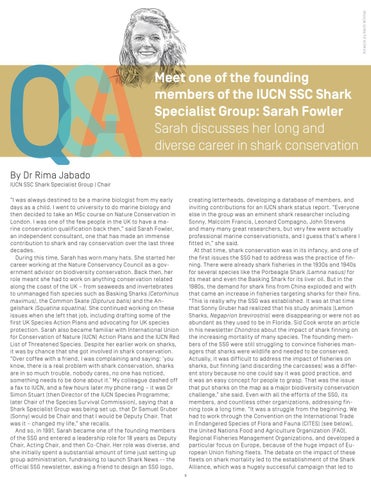Artwork by Keith Witmer
Meet one of the founding members of the IUCN SSC Shark Specialist Group: Sarah Fowler Sarah discusses her long and diverse career in shark conservation By Dr Rima Jabado IUCN SSC Shark Specialist Group | Chair “I was always destined to be a marine biologist from my early days as a child. I went to university to do marine biology and then decided to take an MSc course on Nature Conservation in London. I was one of the few people in the UK to have a marine conservation qualification back then,” said Sarah Fowler, an independent consultant, one that has made an immense contribution to shark and ray conservation over the last three decades. During this time, Sarah has worn many hats. She started her career working at the Nature Conservancy Council as a government advisor on biodiversity conservation. Back then, her role meant she had to work on anything conservation related along the coast of the UK – from seaweeds and invertebrates to unmanaged fish species such as Basking Sharks (Cetorhinus maximus), the Common Skate (Dipturus batis) and the Angelshark (Squatina squatina). She continued working on these issues when she left that job, including drafting some of the first UK Species Action Plans and advocating for UK species protection. Sarah also became familiar with International Union for Conservation of Nature (IUCN) Action Plans and the IUCN Red List of Threatened Species. Despite her earlier work on sharks, it was by chance that she got involved in shark conservation. “Over coffee with a friend, I was complaining and saying: ‘you know, there is a real problem with shark conservation, sharks are in so much trouble, nobody cares, no one has noticed, something needs to be done about it.’ My colleague dashed off a fax to IUCN, and a few hours later my phone rang – it was Dr Simon Stuart (then Director of the IUCN Species Programme; later Chair of the Species Survival Commission), saying that a Shark Specialist Group was being set up, that Dr Samuel Gruber (Sonny) would be Chair and that I would be Deputy Chair. That was it – changed my life,” she recalls. And so, in 1991, Sarah became one of the founding members of the SSG and entered a leadership role for 18 years as Deputy Chair, Acting Chair, and then Co-Chair. Her role was diverse, and she initially spent a substantial amount of time just setting up group administration, fundraising to launch Shark News -- the official SSG newsletter, asking a friend to design an SSG logo,
creating letterheads, developing a database of members, and inviting contributions for an IUCN shark status report. “Everyone else in the group was an eminent shark researcher including Sonny, Malcolm Francis, Leonard Compagno, John Stevens and many many great researchers, but very few were actually professional marine conservationists, and I guess that’s where I fitted in,” she said. At that time, shark conservation was in its infancy, and one of the first issues the SSG had to address was the practice of finning. There were already shark fisheries in the 1930s and 1940s for several species like the Porbeagle Shark (Lamna nasus) for its meat and even the Basking Shark for its liver oil. But in the 1980s, the demand for shark fins from China exploded and with that came an increase in fisheries targeting sharks for their fins. “This is really why the SSG was established. It was at that time that Sonny Gruber had realized that his study animals [Lemon Sharks, Negaprion brevirostris) were disappearing or were not as abundant as they used to be in Florida. Sid Cook wrote an article in his newsletter Chondros about the impact of shark finning on the increasing mortality of many species. The founding members of the SSG were still struggling to convince fisheries managers that sharks were wildlife and needed to be conserved. Actually, it was difficult to address the impact of fisheries on sharks, but finning (and discarding the carcasses) was a different story because no one could say it was good practice, and it was an easy concept for people to grasp. That was the issue that put sharks on the map as a major biodiversity conservation challenge,” she said. Even with all the efforts of the SSG, its members, and countless other organizations, addressing finning took a long time. “It was a struggle from the beginning. We had to work through the Convention on the International Trade in Endangered Species of Flora and Fauna (CITES) [see below], the United Nations Food and Agriculture Organization (FAO), Regional Fisheries Management Organizations, and developed a particular focus on Europe, because of the huge impact of European Union fishing fleets. The debate on the impact of these fleets on shark mortality led to the establishment of the Shark Alliance, which was a hugely successful campaign that led to 9



















